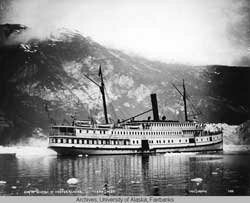|
America's Territory
Rivers get People and Freight Inland
 View of umiaks and wooden boats in the water
View of umiaks and wooden boats in the water
Alaska's major rivers are used to move people and goods from ports to inland areas. Alaskans have used traditional Native boats, American poling boats, rowboats, sailboats and steamboats. A steamboat could move several hundred tons of passengers and goods in one trip and make several trips a season
The Alaska Commercial Company's sternwheeler Yukon started its first voyage up the Yukon River on July 4, 1869. It was pushing two boats with supplies and carrying a government surveying party. It took the boat 23 days to go 1,000 miles upriver to Fort Yukon. Until 1878, the Yukon operated along the river between May and September. It carried supplies to trading posts on the river, took furs to markets, and moved freight, fur traders, and prospectors up and down the river. A competitor brought a steamboat to the river in 1878, and others followed, but in each case, the Alaska Commercial Company soon bought them out. After word spread about the Klondike's gold, 30 steamboat companies formed to operate boats on the Yukon River. A boat could pay for itself on a single trip upriver. The Leah took 300 passengers and 600 tons of freight on its first trip from St. Michael to Dawson and had a $41,000 profit. On other trips 20 days from St. Michael to Dawson and 10 days for the return the profit was $131,000. The gold rush era steamboats accounted for most of the nearly 300 steamboats known to have been used on the Yukon River.
 Steamship "City of Seattle" at Foster Glacier
Steamship "City of Seattle" at Foster Glacier
Steamboats burned wood. A two-boiler boat needed about two cords of wood an hour, round the clock. Boats had to stop every 10 to 12 hours for wood. At first boat crews cut wood, but soon wood camps were set up. The camps provided employment for Natives and disappointed prospectors. The steamboats also had to stop often to clean their boilers. It took about 10 hours to put out the wood fire, allow the boiler to cool, wash the boilers, and replace salt water with river water or remove mud that built up from the river water. On the lower Yukon, where the river was broad and flat, boats could go seven miles an hour upriver. Above the Tanana River, progress was slower. Natives who knew the channels and bends in the rivers were hired as pilots to guide the boats through stretches of the upper river. Other Natives worked as firemen and deckhands on the boats.
River traffic slowed by 1901. In 1923 the Alaska Railroad began a riverboat service that lasted until 1954. Airplanes increasingly carried freight and passengers around Interior Alaska. A group of business people who had been operating small boats on the Yukon River formed the Yutana Barge Line and bought the railroad's river division. The company used modern, smaller boats and with the increased demand for bulk petroleum, was able to make a profit.
|

